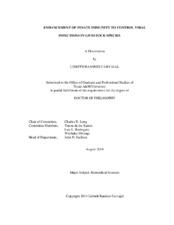| dc.contributor.advisor | Long, Charles R | |
| dc.creator | Ramirez Carvajal, Lisbeth | |
| dc.date.accessioned | 2015-02-05T17:26:30Z | |
| dc.date.available | 2016-08-01T05:30:08Z | |
| dc.date.created | 2014-08 | |
| dc.date.issued | 2014-07-08 | |
| dc.date.submitted | August 2014 | |
| dc.identifier.uri | https://hdl.handle.net/1969.1/153443 | |
| dc.description.abstract | During viral infection, host cell elicits the innate immune response by sensing pathogen associated molecular patterns (PAMPs) and triggering pathways that usually converge in the activation of interferon (IFN) and interferon stimulated genes (ISGs). Foot-and-mouth disease virus (FMDV) and vesicular stomatitis virus (VSV) are distinct economically important viruses that cause clinically indistinguishable vesicular lesions in livestock; yet, both viruses are highly susceptible to IFN.
IFN regulatory factor 7 (IRF-7) is the main regulator of type I IFNs. Elongation initiation factor 4E binding proteins (4eBPs) and 2'-5'-oligoadenylate synthetase like-1 (OASL-1) are translational regulators of IRF-7 in mice. To possibly enhance the antiviral response, the present work investigated the regulatory mechanism of IRF-7-mediated IFN response in livestock species. First, 4eBPs transcripts were decreased by small interfering RNAs (siRNA) in bovine and porcine cells (~60-90 % relative reduction), but no effect on antiviral state was observed. However, porcine cells fully depleted of 4eBP-1 by CRISPR/Cas9 gene editing induced higher levels of IFN, ISGs transcripts, and lower VSV yields (~2 log10), demonstrating that antiviral response is enhanced after 4eBP-1 elimination.
Interestingly, an inhibitory effect over translation exerted by the 5’ untranslated region (5’UTR) of porcine IRF-7 (5’UTR poIRF-7) was independent of 4eBP-1 depletion or hyperactivation. Our RNA folding models of 5’UTR poIRF-7 failed to explain these effects. Additionally, knockdown or over-expression of porcine OASL had minor effects over VSV replication or ISGs induction in swine cells. Thus, regulation of the antiviral state might involve 4eBP-1 and IRF-7 5’UTR but not OASL in porcine cells.
Lastly, a constitutively active fusion of poIRF-7 and poIRF-3 proteins [poIRF7/3(5D)] potently induced IFNα, β, and ω but not type III IFN, causing a significant and steady reduction in FMDV and VSV titers (~6 log10) and enhancement of IFNβ antiviral effects. Mice inoculated with a replication-defective adenovirus (Ad5) expressing poIRF7/3(5D) displayed high antiviral activity in sera, induction of IFNα/β, and no viremia upon FMDV challenge. These results highlight for the first time the
antiviral potential of Ad5-poIRF7/3(5D) in vitro and in vivo against FMDV. Results described here may improve biotechnology tools to defend our agriculture animal resources against viral diseases. | en |
| dc.format.mimetype | application/pdf | |
| dc.language.iso | en | |
| dc.subject | Antiviral state | en |
| dc.subject | Foot-and-mouth and disease | en |
| dc.subject | Vesicular stomatitis virus | en |
| dc.subject | type I Interferon | en |
| dc.subject | antivirals | en |
| dc.subject | Interferon regulatory factors | en |
| dc.subject | porcine OASL | en |
| dc.subject | CRISPR/cas system | en |
| dc.title | Enhancement of Innate Immunity to Control Viral Infections in Livestock Species | en |
| dc.type | Thesis | en |
| thesis.degree.department | Veterinary Physiology and Pharmacology | en |
| thesis.degree.discipline | Biomedical Sciences | en |
| thesis.degree.grantor | Texas A & M University | en |
| thesis.degree.name | Doctor of Philosophy | en |
| thesis.degree.level | Doctoral | en |
| dc.contributor.committeeMember | de los Santos, Teresa | |
| dc.contributor.committeeMember | Rodriguez, Luis L | |
| dc.contributor.committeeMember | Mwangi, Waithaka | |
| dc.type.material | text | en |
| dc.date.updated | 2015-02-05T17:26:30Z | |
| local.embargo.terms | 2016-08-01 | |
| local.etdauthor.orcid | 0000-0001-9653-9024 | |


